Antique glass
Post from EditorialsIn many old houses there are still beautiful stained glass windows or entire stained glass windows with figurative scenes, coats of arms or floral patterns.
Origin of decorative windows
 The oldest archaeological evidence of the use of glass in the windows date back to the ancient Rome, and more specifically to the archaeological excavations of Pompeii and Herculaneum: the richest thermal buildings (and maybe even some domus and villas of wealthy families particularly) are also fitted with wide windows protected by thick sheets of translucent glass mounted on primitive wooden, metal or ceramic frames (the latter obviously fixed, ie non-opening).
The oldest archaeological evidence of the use of glass in the windows date back to the ancient Rome, and more specifically to the archaeological excavations of Pompeii and Herculaneum: the richest thermal buildings (and maybe even some domus and villas of wealthy families particularly) are also fitted with wide windows protected by thick sheets of translucent glass mounted on primitive wooden, metal or ceramic frames (the latter obviously fixed, ie non-opening).
These plates, small, were obtained by casting the glass on one floor, and therefore contained many bubbles and impurities: although let in the sunlight, it was then possible to see outside.
During the Middle Ages, and especially with the spread of the Gothic style (which, freeing the wall from its load-bearing function, made possible the use of large mullioned windows) this technology was rediscovered and greatly improved. All the main churches were in fact equipped with large rosettes and windows decorated with large stained glass formed by thin sheets of colored glass held in place by strips of lead: is referred to as leaded glass.
However, given their large size and their great weight, these windows were open, and not to be damaged by the wind required an elaborate bearing structure of vertical and horizontal iron fixtures firmly fixed into the wall.
The figurative repertoire covered both subjects of sacred origin, as images of saints and scenes from the life of Christ, the Virgin and the prophets; and secular, as the signs of the zodiac, the seasons, the months of the year, the craftsmanship or agricultural and coats of arms of the lords of the place and/ or the possible donors.
From the XV-XVI century, the stained glass began to spread even in wealthier houses and noble buildings are so simple glazed plates formed from translucent or transparent square, diamond-shaped or rectangular, geometric and floral motifs, and finally crests and heraldic devices.
More recently, during the Art Nouveau period and in Art Deco stained glass took on particular importance in the decoration of buildings, porches, train stations and/ or subway stations, and even luxury ocean liners like the Titanic.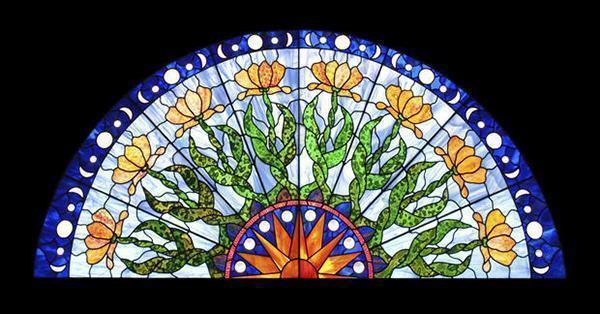
The main subjects are of geometric or floral origin, and the leaded glass are used to buffer doors, windows, shop windows and coffee shops or even entire domes and greenhouses in the mid nineteenth century was inaugurated the first building entirely glazed, the famous Crystal Palace in London, site of the First World Exposition (Expo) of history.
Types of blown glass
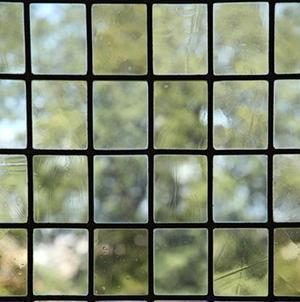 The leaded glasses can take on different aspects based on various factors: the complexity of the motif (complex figurative scenes, floral motifs or simple fillings rectangular or lozenge), to the use of colored glass and/ or transparent, and finally to the execution technique of the individual elements.
The leaded glasses can take on different aspects based on various factors: the complexity of the motif (complex figurative scenes, floral motifs or simple fillings rectangular or lozenge), to the use of colored glass and/ or transparent, and finally to the execution technique of the individual elements.
This last aspect in particular is very important, because the technical execution of the plates not only directly affects the final look of the glass but, properly combining the various types of basic elements, greatly expands the expressive possibilities of this art.
The basic technique is obviously the SBM, which can nevertheless undergo some variations.
According to the method most widely used, the glass master arranged to shape a cylinder similar to a tube, which, still malleable, was cut on one side and lying on a floor. The result was a very thin transparent plate, of small size, irregular in shape and often with obvious defects such as uneven thickness or the presence of bubbles: in fact, given the high number of elements needed for the assembly of a single glass window, to be profitable production had to be very fast and not too accurate.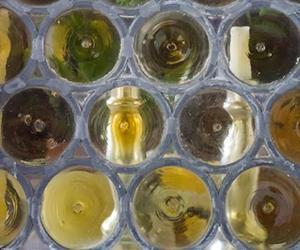 A variant allows instead to obtain so-called glass roller, consisting of small disks of uneven thickness (often greater than the normal wafers), non-transparent and having a diameter of generally between 6 and 12 cm.
A variant allows instead to obtain so-called glass roller, consisting of small disks of uneven thickness (often greater than the normal wafers), non-transparent and having a diameter of generally between 6 and 12 cm.
In this case the starting form is in fact a bubble (similar to that required to attain for example a pot) by the appropriate dimensions, that once contoured was flattened on one floor, detached from the barrel of the blower and allowed to cool: the disks so produced them easy to identify the small central recess vaguely like a navel, due to the presence of the barrel of the blower.
Stained glass, gold and grisaille
Of course, the decorative glass used in the windows may be transparent or translucent (that is, able to let the light pass but not to allow the vision of the external images), colorless or transparent, golden or treated with the technique of grisaille. 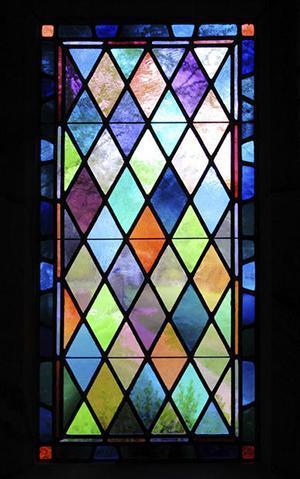 In general, a very thin glass is transparent and free of defects, while a thicker film is translucent; the presence of defects tends to greatly distort the images visible in transparency.
In general, a very thin glass is transparent and free of defects, while a thicker film is translucent; the presence of defects tends to greatly distort the images visible in transparency.
For coloring a glass, it is also necessary to mix the raw materials (generally constituted by siliceous sand, minerals quartzose and/ or limestone, and finally a flux as natron, soda or potash) of the dyes of mineral origin: manganese oxides for glass perfectly colorless (the natural color of this material is in fact bluish-greenish); copper, iron and cobalt green, blue, yellow, red, purple and brown.
The golden glass is obtained instead by a method very similar to that used for the mosaics, namely, simply by inserting a very thin gold leaf between two colorless glass plates.
The grisaille is ultimately a particular painting technique which allows to obtain geometrical or figurative decorations on a single sheet of glass by means of the drawing with a brush of a special paint of glass powder and iron oxide or copper which, when heated, becomes an integral part of the glass.
Construction of a decorative glass window
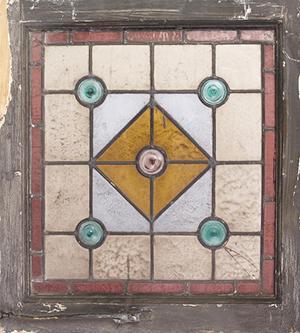 Once the glass elements were ready, it was necessary to build it properly to compose the desired window.
Once the glass elements were ready, it was necessary to build it properly to compose the desired window.
In the case of the specimens with figurative elements, the first thing was to realize a carton in scale 1:1 on the basis of the preparatory sketch, also deciding the position of the strips of lead, usually coincident with the contours of the figures or their individual parts (such as the face, hands and clothes).
It then passed to the cutting of glass pieces: in the case of simple stained glass it was simply to regularize the contours of the various plates, while in the complex figurative glass windows was to cut following predetermined shapes derived from the carton. Any cutting defects were regularized with lime and scouring powder.
At this point glass pieces were inserted within lead rulers specially crafted, filling the residual hollow spaces with a pasty compound to prevent the movement and the possible extraction of the glasses; and the intersections between the strips were finally firmly fixed by welding.
In the case of particularly big windows, it was also arranged a reinforcing structure and support elements in iron.
79806 REGISTERED USERS










